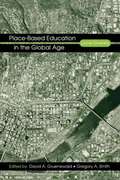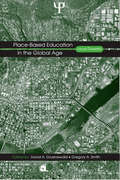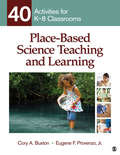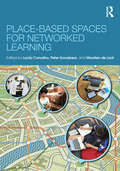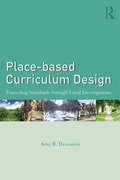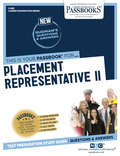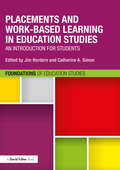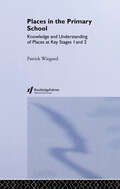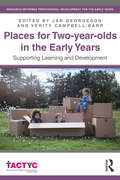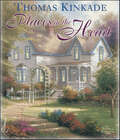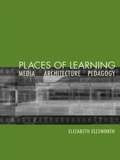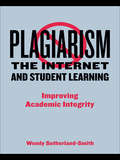- Table View
- List View
Place, Race, and Identity Formation: Autobiographical Intersections in a Curriculum Theorist's Daily Life (Studies in Curriculum Theory Series)
by Ed Douglas McKnightIn this work of curriculum theory, Ed Douglas McKnight addresses and explores the intersections between place (with specific discussion of Kincheloe’s and Pinar’s conceptualization of place and identity) and race (specifically Winthrop Jordan’s historical analysis of race as an Anglo-European construction that became the foundation of a white mythos). To that end, he employs a form of narrative construction called curriculum vitae (course of life)—a method of locating and delineating identity formation which addresses how theories of place, race and identity formation play out in a particular concrete life. By working through how place racializes identity and existence, the author engages in a long Southern tradition of storytelling, but in a way that turns it inside out. Instead of telling his own story as a means to romanticize the sins of the southern past, he tells a new story of growing up within the "white" discourse of the Deep South in the 1960s and 70s, tracking how his racial identity was created and how it has followed him through life. Significant in this narrative is how the discourse of whiteness and place continues to express itself even within the subject position of a curriculum theorist teaching in a large Deep South university. The book concludes with an elaboration on the challenges of engaging in the necessary anti-racist complicated conversation within education to begin to work through and cope with heavy racialized inheritances.
Place- and Community-Based Education in Schools (Sociocultural, Political, and Historical Studies in Education)
by David Sobel Gregory A. SmithPlace- and community-based education – an approach to teaching and learning that starts with the local – addresses two critical gaps in the experience of many children now growing up in the United States: contact with the natural world and contact with community. It offers a way to extend young people’s attention beyond the classroom to the world as it actually is, and to engage them in the process of devising solutions to the social and environmental problems they will confront as adults. This approach can increase students’ engagement with learning and enhance their academic achievement. Envisioned as a primer and guide for educators and members of the public interested in incorporating the local into schools in their own communities, this book explains the purpose and nature of place- and community-based education and provides multiple examples of its practice. The detailed descriptions of learning experiences set both within and beyond the classroom will help readers begin the process of advocating for or incorporating local content and experiences into their schools.
Place- and Community-based Education in Schools
by David Sobel Gregory A. SmithPlace- and community-based education – an approach to teaching and learning that starts with the local – addresses two critical gaps in the experience of many children now growing up in the United States: contact with the natural world and contact with community. It offers a way to extend young people’s attention beyond the classroom to the world as it actually is, and to engage them in the process of devising solutions to the social and environmental problems they will confront as adults. This approach can increase students’ engagement with learning and enhance their academic achievement. Envisioned as a primer and guide for educators and members of the public interested in incorporating the local into schools in their own communities, this book explains the purpose and nature of place- and community-based education and provides multiple examples of its practice. The detailed descriptions of learning experiences set both within and beyond the classroom will help readers begin the process of advocating for or incorporating local content and experiences into their schools.
Place-Based Community Engagement in Higher Education: A Strategy to Transform Universities and Communities
by Erica K. Yamamura Kent KothWhile an increasing number of universities have or are committed to engaging their campuses in their surrounding communities, many recognize they lack the strategic focus and resources to maximize and sustain their impact on those communities. Place-based community engagement provides a powerful way to creatively connect campus and community to foster positive social transformation.In developing community engagement strategies, most universities and community organizations face significant challenges in deciding who to partner with and why. Frequently this leads universities and community organizations to say “yes” to too many opportunities which significantly limit their ability to pursue long-term impact. Focusing on an established geographic area can make it much easier to decide where to deploy resources and which partnerships to prioritize and thus increase their ability to form strong and sustainable partnerships that are of greater value to all stakeholders.This book presents the emerging model of place-based community engagement as a powerful process for attaining more positive and enduring results in their local communities as well as stimulating wider engagement by campus constituencies. Drawing upon the concept of collective impact and using data-driven decision making, place-based initiatives build long-term partnerships based upon a shared vision. Done thoughtfully, these place-based initiatives have attained impressive results.Drawing upon the case studies of five institutions that have implemented place-based community engagement initiatives, the authors provide guidance on the opportunities, challenges, and considerations involved in putting a place-based approach into effect. By sharing the experiences of these five institutions, they describe in detail the routes each took to turn their place-based initiatives from concept to reality, and the results they achieved.
Place-Based Education in the Global Age: Local Diversity
by Gregory A. Smith David A. GruenewaldThe book is a collection of success stories from around the United States and explores some of the reasons for pursuing place-based education.It shows how educators from diverse places are using place as a focal point for developing community leaders, understanding the tensions between Israel and Palestine, and for showing future teachers the power of place-based learning.
Place-Based Education in the Global Age: Local Diversity
by Gregory A. Smith David A. Gruenewald"Polished, clear, insightful, and meaningful.... This volume amounts to nothing less than a complete rethinking of what progressive education can be at its best and how education can be reconceptualized as one of the central practices of a genuinely democratic and sustainable society.... It is the kind of book that has the potential to be transformative." Stephen Preskill, University of New Mexico "The editors and contributors are pioneers in the field of educational theory, policy, and philosophy.... They are opening new areas of inquiry and educational reform in ways that promise to make this book in very short time into a classic.... The practical applications and experiments included reveal the richness of grassroots initiatives already underway to bring educational theory and policy down to earth. While spanning the richest and deepest intellectual ideas and concepts, the stories told are the types that practitioners and teachers will be able to relate to in their daily undertakings." Madhu Suri Prakash, The Pennsylvania State University This volume – a landmark contribution to the burgeoning theory and practice of place-based education – enriches the field in three ways: First, it frames place-based pedagogy not just as an alternative teaching methodology or novel approach to environmental education but as part of a broader social movement known as the "Anew localism", which aims toward reclaiming the significance of the local in the global age. Second, it links the development of ecological awareness and stewardship to concerns about equity and cultural diversity. Third, it presents examples of place-based education in action. The relationship between the new localism and place-based education is clarified and the process of making connections between learners and their wider communities is demonstrated. The book is organized around three themes: Reclaiming Broader Meanings of Education; Models for Place-Based Learning; and Global Visions of the Local in Higher Education This is a powerfully relevant volume for researchers, teacher educators, and students across the fields of curriculum theory, educational foundations, critical pedagogy, multicultural education, and environmental education.
Place-Based Science Teaching and Learning: 40 Activities for K-8 Classrooms
by Dr Cory A. Buxton Dr Eugene F. ProvenzoForty classroom-ready science teaching and learning activities for elementary and middle school teachersGrounded in theory and best-practices research, this practical text provides elementary and middle school teachers with 40 place-based activities that will help them to make science learning relevant to their students. This text provides teachers with both a rationale and a set of strategies and activities for teaching science in a local context to help students engage with science learning and come to understand the importance of science in their everyday lives.
Place-Based Science Teaching: Connecting Students to Curriculum, Community, and Caring for Our Planet
by Whitney Aragaki Kirstin MilksJumpstart your imagination and transform your science classroom by centering place-based learning Identity, community, and place are tightly connected and can be leveraged to deepen science learning for students. Place-Based Science Teaching offers K-12 science educators an innovative approach to building learning experiences that embrace the rich and varied knowledge held by people, both past and present, about the places we call home. This book helps teachers to foster greater personal investment of students in their learning, as well as develop NGSS-informed authentic problem-solving and critical reasoning skills. The book will also help teachers create and find joy in their classrooms by connecting lessons to local environments, cultural heritage, and global issues. Written by nationally recognized STEM educators Whitney Aragaki and Kirstin Milks, the book blends inspiring storytelling with practical frameworks and resources. Chapters will take you behind the scenes into innovative classrooms, detailing high-impact, standards-aligned activities and sharing educator stories from diverse settings. Grounded in cutting-edge research and real-world examples, Place-Based Science Teaching Introduces the Place Based Science Teaching Framework that asks "where are you," "when are you," "who are you," and "who are we together" as a way to connect learning to local and global contexts Provides classroom-ready lessons and case studies from many educational settings, aligned with NGSS and centered on belonging, access, and engagement Offers strategies for virtual spaces and digital perspectives to enhance teaching in an increasingly online world Includes actionable reflection prompts designed to help teachers explore their own positionality and better connect with their students and communities This book will encourage educators and administrators alike to transform science learning into an opportunity for building empathy, connection, and hope. Place-Based Science Teaching is designed to help teachers foster a sense of place and stewardship among their students, and address peace- and justice-focused solutions that encourage students to care for their communities, think critically about global challenges, and develop the agency to lead for generations to come.
Place-Based Science Teaching: Connecting Students to Curriculum, Community, and Caring for Our Planet
by Whitney Aragaki Kirstin MilksJumpstart your imagination and transform your science classroom by centering place-based learning Identity, community, and place are tightly connected and can be leveraged to deepen science learning for students. Place-Based Science Teaching offers K-12 science educators an innovative approach to building learning experiences that embrace the rich and varied knowledge held by people, both past and present, about the places we call home. This book helps teachers to foster greater personal investment of students in their learning, as well as develop NGSS-informed authentic problem-solving and critical reasoning skills. The book will also help teachers create and find joy in their classrooms by connecting lessons to local environments, cultural heritage, and global issues. Written by nationally recognized STEM educators Whitney Aragaki and Kirstin Milks, the book blends inspiring storytelling with practical frameworks and resources. Chapters will take you behind the scenes into innovative classrooms, detailing high-impact, standards-aligned activities and sharing educator stories from diverse settings. Grounded in cutting-edge research and real-world examples, Place-Based Science Teaching Introduces the Place Based Science Teaching Framework that asks "where are you," "when are you," "who are you," and "who are we together" as a way to connect learning to local and global contexts Provides classroom-ready lessons and case studies from many educational settings, aligned with NGSS and centered on belonging, access, and engagement Offers strategies for virtual spaces and digital perspectives to enhance teaching in an increasingly online world Includes actionable reflection prompts designed to help teachers explore their own positionality and better connect with their students and communities This book will encourage educators and administrators alike to transform science learning into an opportunity for building empathy, connection, and hope. Place-Based Science Teaching is designed to help teachers foster a sense of place and stewardship among their students, and address peace- and justice-focused solutions that encourage students to care for their communities, think critically about global challenges, and develop the agency to lead for generations to come.
Place-Based Scientific Inquiry: A Practical Handbook for Teaching Outside
by Benjamin Wong Blonder Ja'Nya Banks Austin Cruz Anna Dornhaus R. Keating Godfrey Joshua S. Hoskinson Rebecca Lipson Pacifica Sommers Christy Stewart Alan StraussLearn how to facilitate scientific inquiry projects by getting out of the classroom and connecting to the natural environment—in your schoolyard, or in your community! Providing a contemporary perspective on how to do scientific inquiry in ways that can make teachers’ lives easier and students’ experiences better, this book draws on authentic inquiry, engaging with communities, and teaching through project-based learning to help students design and carry out scientific inquiry projects that are grounded in their local places. This accessible guide will help you to develop skills around facilitation, team building, and learning outdoors in schoolyards and parks, acting as a go-to toolkit for teachers to help build confidence and skills in these areas. Written according to the Next Generation Science Standards, this book supports teachers in fostering community engagement and a justice-first classroom. The approachable resources included in this book will help teachers with all levels of experience succeed in empowering students grades 3–12 in their science learning. Additional support materials including template documents for student use and for teacher planning, as well as examples of real student work, are available online. The Open Access version of this book, available at www.taylorfrancis.com, has been made available under a Creative Commons Attribution (CC-BY) 4.0 license
Place-Based Spaces for Networked Learning
by Lucila Carvalho, Peter Goodyear and Maarten de LaatWith the boundaries of place softened and extended by digital communications technologies, learning in a networked society necessitates new distributions of activity across time, space, media, and people; and this development is no longer exclusive to formally designated spaces such as school classrooms, lecture halls, or research laboratories. Place-based Spaces for Networked Learning explores how qualities of physical places make both formal and informal education in a networked society possible. Through a series of investigations and case studies, it illuminates the structural composition and functioning of complex learning environments. This book offers a wealth of key design elements and attributes for productive learning that educational designers can reuse in multiple contexts. The chapters examine how places are modified, expanded, or supplemented by networking technologies and practices in order to create spaces in which learners can collaboratively develop new understandings, connections, and capabilities. Utilizing a range of diverse but complementary perspectives from anthropology, archaeology, architecture, geography, psychology, sociology, and urban studies, Place-based Spaces for Networked Learning addresses how material places and digital spaces are understood; how sense can be made of new assemblages and configurations of tasks, tools, and people; how the real-time analysis of new flows of data can inform and entertain users of a space; and how access to the digital realm changes our experiences with both places and other people.
Place-Based Writing in Action: Opportunities for Authentic Writing in the World Beyond the Classroom
by Rob Montgomery Amanda MontgomeryThis text presents a variety of ways for students to meet traditional instructional goals in writing while also learning how writing can help them become stewards of the natural world and advocates for their own communities. Built on a foundation of emerging research and theory and grounded in the lived reality of teachers, this book explores the material and virtual worlds as places that can be equally productive as sources for authentic writing. Readers will find place-based writing activities, lesson ideas, and samples of student work in every chapter. With practical and classroom-tested ideas, Place-Based Writing in Action is a useful text for preservice and in-service English teachers, as well as any educator who wants to move the act of writing beyond the four walls of the classroom.
Place-based Curriculum Design: Exceeding Standards through Local Investigations
by Amy B. DemarestPlace-based Curriculum Design provides pre-service and practicing teachers both the rationale and tools to create and integrate meaningful, place-based learning experiences for students. Practical, classroom-based curricular examples illustrate how teachers can engage the local and still be accountable to the existing demands of federal, state, and district mandates. Coverage includes connecting the curriculum to students’ outside-of-school lives; using local phenomena or issues to enhance students’ understanding of discipline-based questions; engaging in in-depth explorations of local issues and events to create cross-disciplinary learning experiences, and creating units or sustained learning experiences aimed at engendering social and environmental renewal. An on-line resource (www.routledge.com/9781138013469) provides supplementary materials, including curricular templates, tools for reflective practice, and additional materials for instructors and students.
Place-based Learning for the Plate: Hunting, Foraging and Fishing for Food (Environmental Discourses in Science Education #6)
by Michael P. Mueller David Greenwood Joel B. PontiusThis edited volume explores 21st century stories of hunting, foraging, and fishing for food as unique forms of place-based learning. Through the authors’ narratives, it reveals complex social and ecological relationships while readers sample the flavors of foraging in Portland, Oregon; feel some of what it’s like to grow up hunting and gathering as a person of Oglala Lakota and Shoshone-Bannock descent; track the immersive process of learning to communicate with rocky mountain elk; encounter a road-killed deer as a spontaneous source of local meat, and more.Other topics in the collection connect place, food, and learning to issues of identity, activism, spirituality, food movements, conservation, traditional and elder knowledge, and the ethics related to eating the more-than-human world. This volume will bring lively discussion to courses on place-based learning, food studies, environmental education, outdoor recreation, experiential education, holistic learning, human dimensions of natural resource management, sustainability, food systems, environmental ethics, and others.
Placement Representative II: Passbooks Study Guide (Career Examination Series)
by National Learning CorporationThe Placement Representative II Passbook® prepares you for your test by allowing you to take practice exams in the subjects you need to study. It provides hundreds of questions and answers in the areas that will likely be covered on your upcoming exam, including but not limited to: principles and practices of employment counseling; human behavior; preparation of written material; supervision; and other related areas.
Placements and Work-based Learning in Education Studies: An introduction for students (Foundations of Education Studies)
by Catherine A. Simon Jim HordernWritten specifically for education studies students, this accessible text offers a clear introduction to placements and work-based learning, providing an insight into work in schools and education settings. Including case studies to illustrate the diversity of placements and workplace opportunities, it explores the theory and practice of working in educational contexts and supports students as they develop the skills and aptitudes that enhance their employability. With the aim of helping students to prepare for and get the most out of their work placements, chapters include: the nature of work-based learning on placement; preparing for your placement; placements in schools and other educational settings; learning on field trips and study visits; working with students with specific learning difficulties/dyslexia on placement; international placements. Part of the Foundations of Education Studies series, this textbook is essential reading for students undertaking courses in Childhood Studies, Child and Youth Studies and Education Studies.
Places In The Primary School
by Patrick WiegandUsing a cross-curricular approach, Wiegand discusses the knowledge necessary for preparing children for life in a pluralist society. Looking at theories of education for citizenship, environment education and economic and industrial understanding, it examines the evidence for what children know and feel about their own country, other countries and people in "distant" places. He offers practical suggestions for curriculum planning and classroom activities in the primary school and examines ways in which project work on different localities can be initiated and developed.
Places for Two-year-olds in the Early Years: Supporting Learning and Development (TACTYC)
by Jan Georgeson Verity Campbell-BarrGrounded in recent research on the challenges of working with two-year-olds, Places for Two-year-olds in the Early Years explores how this often overlooked age group is presented in policy and practice, and discusses why working with two-year-olds can be both exciting and highly rewarding. The book builds on theoretical understandings of child development, high-quality provision and pedagogical practice, to offer practical solutions for working effectively with two-year-olds and their families in a variety of early years settings. Chapters focus on the specific needs of two-year-olds and the accompanying demands made on settings and practitioners. Many topics are also approached from a practical perspective, prompting readers to consider their own experiences of working with two-year-olds. The book explores: understandings of ‘high quality’ education and care varying workforce requirements and professional development how practitioners develop knowledge(s) about working with two-year-olds physical and social environments for two-year-olds the role of the adult or key person in supporting children’s development provision of services for disadvantaged two-year-olds. With reflective questions and annotated further reading included throughout, Places for Two-year-olds in the Early Years is essential reading for practitioners, policy-makers and students involved in this often overlooked area of early years provision.
Places in the Heart
by Thomas Kinkade"My mission as an artist is to capture those special moments in life adorned with beauty and light. I work to create images that project a serene simplicity that can be appreciated and enjoyed by everyone. That's what I mean by sharing the light." —Thomas KinkadeCollectors and fans worldwide were awed by Thomas Kinkade's mastery of capturing the beauty and warmth of light in subjects as varied as windswept seas, majestic mountains, idyllic meadows, peaceful forest glens, cozy cottages, quaint villages, and inviting front porches. It earned him the nickname "The Painter of Light" and made him America's most widely collected artist.On their own, his tranquil, luminous paintings affirm the basic values of family, home, faith in God, and the beauty of nature. Here, they are displayed with heartwarming and inspirational thoughts and sentiments for an experience that is profoundly moving and uplifting.
Places of Engagement: Reflections on Higher Education in 2040 - A Global Approach
by Rob van der Vaart Armand HeijnenIn his book 'Higher Education in 2040 - A Global Approach' (2017) Bert van der Zwaan developed a thought-provoking vision of the university of the future, based on a thorough discussion of current trends and on a large number of conversations with leaders in higher education worldwide., This book, 'Places of Engagement', offer reflections on themes discussed by Van der Zwaan, written by twenty of his peers and other opinion leaders from around the world. The book was written in honour of Bert van der Zwaan at the occasion of his departure as Vice-Chancellor of Utrecht University., With contributions by John Sexton, José van Dijck, Karl Dittrich, Dilly Fung, Michael Crow and many others.
Places of Inquiry: Research and Advanced Education in Modern Universities
by Burton R. ClarkA distinguished work by one of America's leading scholars of higher education, Places of Inquiry explores one of the major issues in university education today: the relationship among research, teaching, and study. Based on cross-national research on the university systems of Germany, Britain, France, the United States, and Japan—which was first reported in the edited volume The Research Foundations of Graduate Education (California, 1993)—this book offers in-depth comparative analysis and draws provocative conclusions about the future of the research-teaching-study nexus.With characteristic clarity and vision, Burton R. Clark identifies the main features and limitations of each national system: governmental and industrial dominance in Japan, for example, and England's collegiate form of university. He examines the forces drawing research, teaching, and study apart and those binding them together. Highlighting the fruitful integration of teaching and research in the American graduate school, Clark decries the widely held view that these are antithetical activities. Rather, he demonstrates that research provides a rich basis for instruction and learning. Universities, he maintains, are places of inquiry, and the future lies with institutions firmly grounded in this belief.
Places of Learning: Media, Architecture, Pedagogy
by Elizabeth EllsworthThis book takes a close look at places of learning located outside of schools, yet deeply concerned with the experience of the learning self. It explores what it might mean to think of pedagogy not in relation to knowledge as a "thing made," but to knowledge in the making.
Places of Memory: Whiteman's Schools and Native American Communities (Sociocultural, Political, and Historical Studies in Education)
by Alan PeshkinWhile visiting New Mexico, the author was struck with the opportunity the state presents to explore the school-community relationship in rural, religious, and multiethnic sociocultural settings. In New Mexico, the school-community relationship can be learned within four major culture groups -- Indian, Spanish-American, Mexican, and Anglo. Together, studies of these culture groups form a portrait of schooling in New Mexico, further documenting the range of ways that host communities in our educationally decentralized society use the prerogatives of local control to "create" schools that fit local cultural inclinations. The first of four planned volumes, this book studies the Pueblo Indians and Indian High School. The school is a nonpublic, state-accredited, off-reservation boarding school for more than 400 Indian students. A large majority of the students are from Pueblo tribes, while others are from Navajo and Apache tribes. As a state-accredited school, it subscribes to curricular, safety, and other requirements of New Mexico. As a nonpublic school devoted to Indian students, it has the prerogative to be as distinctive as the ethnic group it serves. USE SHORT BLURB COPY FOR CATALOGS: This ethnography of the Pueblo Indians and Indian High School epxlores some of the ways that host communities in our decentralized society use the perogatives of local consul to create schools that fit local cultural inclinations.
Placing Students at the Heart of Creative Learning (Creative Teaching/Creative Schools)
by Nick OwenPlacing Students at the Heart of Creative Learning shows teachers of key stages 2 and 3 how to introduce creativity into what is often seen as a prescriptive and stifling curriculum, and addresses the tensions that can exist between the requirement to follow the curriculum and the desire to employ innovative pedagogies. It offers readers a range of practical and realistic ways that curriculum changing ideas can be applied to individual projects, classrooms and even entire schools. This book tracks the imaginative initiatives undertaken by six schools as they have worked to change their curriculum and teaching in order to put student experiences at the core of the learning process. Stating its observations and suggestions in a refreshingly straightforward and practicable manner, this book explores: Why a new creative curriculum is needed for the 21st century How to encourage teachers and pupils to ‘own’ the curriculum The role that pupil voice plays in a creative curriculum The environment needed to creatively manipulate the curriculum How to introduce innovation to teaching practice What actually works – considering the limits and possibilities of creative pedagogy Providing case studies and examples of the ways in which teachers have delivered the curriculum in a creative way, Placing Students at the Heart of Creative Learning is an invaluably beneficial guide for all those involved in engaging and teaching young people in key stages 2 and 3.
Plagiarism, the Internet, and Student Learning: Improving Academic Integrity
by Wendy Sutherland-SmithWritten for Higher Education educators, managers and policy-makers, Plagiarism, the Internet and Student Learning combines theoretical understandings with a practical model of plagiarism and aims to explain why and how plagiarism developed. It offers a new way to conceptualize plagiarism and provides a framework for professionals dealing with plagiarism in higher education. Sutherland-Smith presents a model of plagiarism, called the plagiarism continuum, which usefully informs discussion and direction of plagiarism management in most educational settings. The model was developed from a cross-disciplinary examination of plagiarism with a particular focus on understanding how educators and students perceive and respond to issues of plagiarism. The evolution of plagiarism, from its birth in Law, to a global issue, poses challenges to international educators in diverse cultural settings. The case studies included are the voices of educators and students discussing the complexity of plagiarism in policy and practice, as well as the tensions between institutional and individual responses. A review of international studies plus qualitative empirical research on plagiarism, conducted in Australia between 2004-2006, explain why it has emerged as a major issue. The book examines current teaching approaches in light of issues surrounding plagiarism, particularly Internet plagiarism. The model affords insight into ways in which teaching and learning approaches can be enhanced to cope with the ever-changing face of plagiarism. This book challenges Higher Education educators, managers and policy-makers to examine their own beliefs and practices in managing the phenomenon of plagiarism in academic writing.




